Introduction: The Era of Human-Machine Integration
As technology advances at an unprecedented pace, humans are increasingly merging with machines to extend cognitive, sensory, and physical capabilities. Cybernetic augmentation — integrating AI, robotics, and neural interfaces — is transforming human potential. Unlike purely biological or mechanical enhancements, AI-integrated systems offer dynamic adaptability, real-time learning, and synergistic collaboration between human intelligence and computational power.
This article explores cybernetic and AI-integrated human augmentation, examining its technologies, applications, ethical considerations, and future implications.
1. Neural Interfaces and Brain-Computer Integration
1.1 Brain-Computer Interfaces (BCIs)
BCIs provide direct communication between the brain and machines. By translating neural activity into actionable commands, BCIs allow:
- Control of robotic limbs and prosthetics
- Interaction with digital environments without physical input
- Real-time augmentation of cognitive processes
1.2 AI-Enhanced BCIs
When integrated with AI, BCIs gain the ability to predict user intent, optimize control, and adapt to changing neural patterns. This improves precision, reduces latency, and enhances overall usability.
1.3 Applications
- Medical: Restoration of mobility for paralyzed patients and rehabilitation therapy
- Industrial: Direct control of robotic systems and machinery
- Military: Augmented situational awareness and rapid decision-making
2. Cognitive Augmentation Through AI
2.1 AI as a Cognitive Partner
AI systems can amplify human intelligence by providing:
- Instant access to vast knowledge repositories
- Predictive insights for decision-making
- Assistance in complex problem-solving
2.2 Human-AI Symbiosis
The collaboration between human creativity and AI computational power enables capabilities beyond either alone. Examples include:
- Complex scientific research and drug discovery
- Real-time strategic planning in emergency response
- Adaptive learning and personalized education
3. Cybernetic Physical Enhancements
3.1 AI-Driven Exoskeletons
Exoskeletons powered by AI algorithms can anticipate user movement, optimize support, and enhance strength and endurance. Applications span industrial, military, and medical contexts, improving performance while minimizing fatigue and injury.
3.2 Prosthetic Limbs and Robotics
AI-integrated prosthetics adapt to user intent and environmental conditions. Sensors and machine learning algorithms allow:
- Fine motor control for tasks requiring dexterity
- Haptic feedback for naturalistic touch perception
- Autonomous assistance during complex activities
3.3 Integration with Wearable Technology
Smart wearables collect physiological and environmental data, allowing AI systems to dynamically adjust physical augmentation and optimize human-machine interaction.

4. Sensory and Perceptual Enhancement
4.1 AI-Enhanced Vision and Hearing
- Computer vision systems interpret surroundings and provide augmented reality overlays
- Auditory AI systems enhance selective hearing and spatial sound awareness
4.2 Expanding Perception Beyond Human Limits
Cybernetic augmentation can translate invisible signals (e.g., electromagnetic fields) into perceivable cues, extending sensory perception beyond biological boundaries. This enables:
- Advanced scientific exploration
- Remote operations in hazardous environments
- Immersive virtual experiences
5. AI-Integrated Decision-Making
5.1 Augmented Judgment
Cybernetic systems analyze data at scales beyond human capacity, offering real-time decision support. This is crucial in:
- Emergency response
- Complex logistical operations
- High-stakes financial or strategic planning
5.2 Predictive Intelligence
Machine learning algorithms anticipate challenges and provide recommendations, enabling humans to act proactively rather than reactively. This predictive capability enhances safety, efficiency, and performance across multiple domains.
6. Ethical and Societal Implications
6.1 Identity and Autonomy
As humans integrate with AI, questions emerge about:
- The boundaries between human decision-making and machine influence
- Responsibility for actions taken with AI assistance
- The definition of individual agency in augmented cognition
6.2 Privacy and Security
Neural and cybernetic systems collect vast amounts of sensitive data. Ensuring privacy, preventing hacking, and protecting mental autonomy are paramount.
6.3 Accessibility and Equity
Advanced augmentation may exacerbate inequalities if access is limited to privileged populations. Equitable distribution and societal inclusion are critical considerations.
6.4 Psychological and Social Effects
Continuous interaction with AI-enhanced systems may alter cognitive processes, social behaviors, and emotional well-being. Users may develop dependencies or experience challenges in distinguishing augmented perception from natural experience.
7. Future Prospects
7.1 Fully Integrated Cybernetic Systems
Future technologies may seamlessly merge human neural networks with AI, creating real-time cognitive and physical symbiosis. Potential applications include:
- Advanced human-computer collaboration
- Superhuman decision-making and problem-solving
- Rapid adaptation to extreme environments
7.2 Collective Human-AI Intelligence
Distributed cybernetic systems could connect multiple humans with shared AI networks, enabling collective intelligence that integrates human creativity with computational scale.
7.3 Ethical Design and Regulation
Future development requires proactive regulation, ethical design, and multidisciplinary collaboration to ensure safe, responsible, and socially beneficial augmentation.
Conclusion: Toward a Symbiotic Future
Cybernetic and AI-integrated augmentation represents a profound leap in human potential. By merging cognition, perception, and physical ability with artificial intelligence, humans can achieve capabilities far beyond natural limitations.
However, this power comes with ethical, social, and psychological responsibilities. Balancing innovation with human values, ensuring equitable access, and protecting autonomy are critical for a future where humans and machines coexist symbiotically.
The integration of AI into human biology and cognition marks not just a technological evolution, but a transformational redefinition of humanity itself, opening possibilities limited only by imagination, ethics, and vision.











































